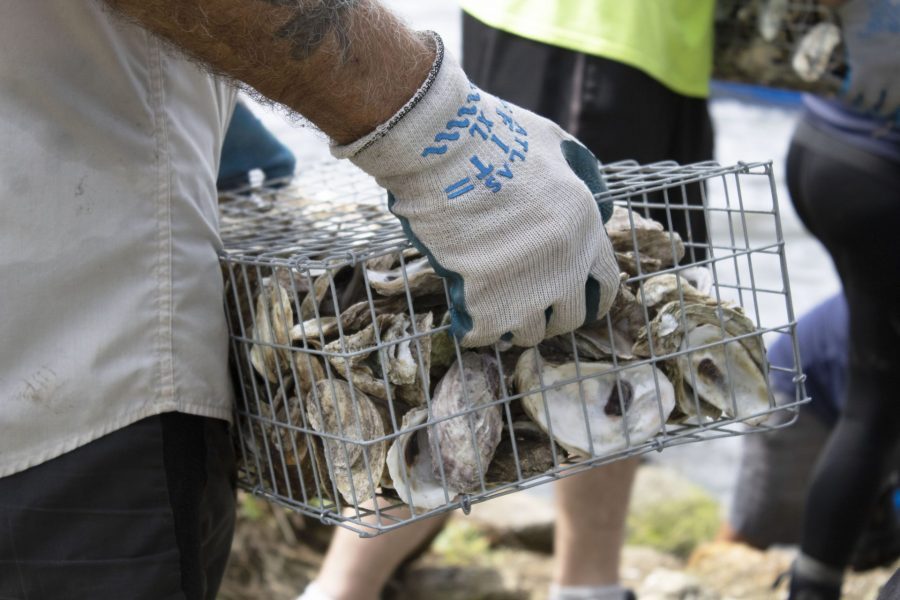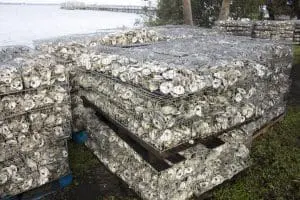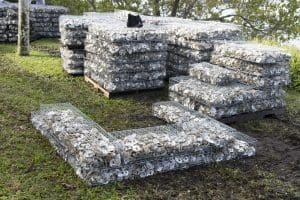

Restore Our Shores team is seeing some promising early results from a plastic-free material in its oyster restoration projects called a gabion.
Our Restore Our Shores team is happy to share that we’ve seen some early success in using a plastic-free material called a gabion in our oyster restoration projects.
“It’s an important step that the Zoo wants to take to reduce manmade materials from our projects,” said Olivia Escandell, Conservation Manager.
An oyster’s favorite home is another oyster’s shell, Olivia explained. The Restore Our Shores team has used plastic mesh bags filled with oyster shells for a few years now to attract oyster spat, or larvae, to attach to the shells and form reef structure.

Restore Our Shores team is seeing some promising early results from a plastic-free material in its oyster restoration projects called gabions.
For about a year, we’ve been using gabions, or galvanized metal cages, on select oyster reef builds. Recently, we joined our partners from UCF to monitor an oyster project built in March 2021 in Melbourne Beach. This is a test site for different restoration methods with a side-by-side comparison between oyster bags and gabions. On average, the gabions at this site naturally recruited almost three times as many live oysters as the bags and the oysters were much larger! We believe the gabion’s height and larger holes allow for better water flow and less sedimentation, increasing the potential for oyster spawn to attach to the shells inside. The greater water flow could also increase food availability, leading to faster growth rates of the oysters.
“Containing the shell also allows more time for live oysters and reef structure to form and hold shell together before wave action erodes or flattens how the shell is built up,” Olivia said. “Gabions provide a plastic-free way of doing this and may hold up better than plastic mesh bags.”
While the bags have done well overall, our team believe switching to gabions will help the lagoon by encouraging more oysters to grow on the projects, removing plastics from the waterway, protecting marine life from the potential harm of entanglement and micro-plastics and providing a material that will hold up better in active lagoon areas.
“Plastic pollution in our marine environment is a growing problem,” Olivia said. “Because plastics are not biodegradable, they can persist in the environment and create hazards.”
Although we haven’t seen wildlife entanglements in our mesh bags firsthand, we have found oyster bags dislodged from projects in very high-energy areas. These high-energy areas also have limited success with oyster bags, so we’re hoping the gabions will make our reefs stronger.
Gabions cost significantly more than mesh bags and take much more time to build, so their use will depend on the project initially, but we look forward to slowly making this transition!
“We are so thankful to our many volunteers that have helped us construct thousands of gabions so far (always looking for more),” Olivia said.
The Brevard County Save Our Indian River Lagoon Project Plan funds our oyster projects because of their ability to remove nutrients from the water column, provide habitat for local wildlife and protect shorelines.

Restore Our Shores team is trying a different way to build oyster reefs: Gabion corrals.
As we continue to work with gabions, we’re trying another innovative oyster reef building method: gabion corrals. Our team recently built a “corral” using gabions in Melbourne Beach, filling the center of the corral with loose oyster shells. This method removes even more foreign materials from the lagoon while still adding oyster shells and protecting other habitats and the shoreline.
“Oyster corrals may not produce oyster densities as high as gabions or even bags because the shell will be more exposed to predators, but if we can produce good oyster habitat with less ‘unnatural’ materials it may be worth the trade-off,” Olivia said. “This is the lagoon’s first oyster corral project, but we will be building more to test their feasibility at multiple locations.”
Other oyster restoration practitioners and programs have used this method with success, so we’re hoping to see similar positive results during future monitoring sessions!
Brevard Zoo is an independent, not-for-profit organization that receives no recurring government funding for our operating costs. Your generous support enables us to continue to serve our community and continue our vital animal wellness, education and conservation programs.